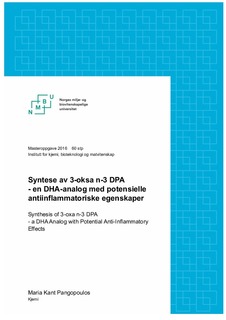| dc.contributor.advisor | Stenstrøm, Yngve | |
| dc.contributor.advisor | Hansen, Trond Vidar | |
| dc.contributor.author | Pangopoulos, Maria Kant | |
| dc.date.accessioned | 2016-08-10T12:30:25Z | |
| dc.date.available | 2016-08-10T12:30:25Z | |
| dc.date.issued | 2016-08-10 | |
| dc.identifier.uri | http://hdl.handle.net/11250/2398674 | |
| dc.description.abstract | Det er stor interesse for å studere både kjemiske og biologiske egenskaper av flerumettede ω-3 fettsyrer, som dokosaheksaensyre, (4Z,7Z,10Z,13Z,16Z,19Z)-dokosa-4,7,10,13,16,19-heksaensyre (DHA) (15). I denne oppgaven er det utviklet en metode for syntese av DHA-analogen 3-oksa n-3 DPA (11).
Etylesteren av DHA (1) ble benyttet som utgangsmateriale for syntesen, og etter kjente metoder ble DHA-EE omsatt til C-18 aldehydet (3Z,6Z,9Z,12Z,15Z)-oktadeka-3,6,9,12,15-pentaenal (4), som deretter ble forlenget til C-19 aldehydet (4Z,7Z,10Z,13Z,16Z)-nonadeka-4,7,10,13,16-pentaenal (8). En ny metode ble utviklet for syntesen av 11, hvor tert-butyl bromacetat ble benyttet sammen med en faseoverføringskatalysator i et tofasesystem. Den totale syntesen involverte 10 reaksjonstrinn, og ga et utbytte på 8 %.
3-oksa n-3 DPA (11) er interessant med tanke på biologisk aktivitet, da den kan være substrat for humant 15-LOX, og dermed danne nye oksygenerte fettsyrederivater med antiinflammatoriske og vevsbeskyttende egenskaper. Ved å ha innført oksygen i β-posisjon i forbindelsen, vil den oksidative degraderingen av fettsyren forhindres. Dette kan resultere i en forbedret biologisk aktivitet. Det er påbegynt innledende biologiske studier av 3-oksa n-3 DPA (11), men det ble ikke tid til å fullføre studiene innenfor den gitte tidsrammen.
3-oksa n-3 DPA (11) har også blitt benyttet til å syntetisere dimetylamidet N,N-dimetyl-2-(((4Z,7Z,10Z,13Z,16Z)-nonadeka-4,7,10,13,16-pentaen-1-yl)oxy)acetamid (12).
Denne forbindelsen kan inneha inhibitor-egenskaper, og bør også testes videre biologisk. | nb_NO |
| dc.description.abstract | Great interest has been shown for the studies of both chemical and biological properties of the polyunsaturated ω-3 fatty acids, like docosahexaenoic acid, (4Z,7Z,10Z,13Z,16Z,19Z)-docosa-4,7,10,13,16,19-hexaenoic acid (DHA) (15). A method for the synthesis of the DHA analog 3-oxa n-3 DPA (11) has been developed in this thesis.
The ethyl ester of DHA (1) was used as starting material for the synthesis, and was converted to the C-18 aldehyde (3Z,6Z,9Z,12Z,15Z)-octadeka-3,6,9,12,15-pentaenal (4), which was subsequently extended to the C-19 aldehyde (4Z,7Z,10Z,13Z,16Z)-nonadeka-4,7,10,13,16-pentaenal (8). This work was done following well-known procedures.
A new method was developed for the synthesis of 11, where tert-butyl bromoacetate was used along with a phase transfer catalyst in a biphasic system. The overall synthesis involved 10 reaction steps and gave a total yield of 8 %.
3-oxa n-3 DPA (11) is interesting in terms of biological activity, as it can be a substrate for human 15-LOX, thus forming new Specialized Proresolving Lipid Mediators (SPMs) with anti-inflammatory and tissue protectant properties. By having introduced oxygen in the β-position in 11, the oxidative degradation of the fatty acid is prevented. This may result in an improved biological activity. A preliminary biological study of 3-oxa n-3 DPA (11) has been started, but there was no time to complete the study within the given time frame.
3-oxa n-3 DPA (11) has also been used as starting material for the synthesis of the dimethyl amide N,N-dimethyl-2-(((4Z,7Z,10Z,13Z,16Z)-nonadeca-4,7,10,13,16-pentaen-1-yl)oxy) acet-amide (12). This compound may possess inhibitor properties, and should also be studied biologically. | nb_NO |
| dc.language.iso | nob | nb_NO |
| dc.publisher | Norwegian University of Life Sciences, Ås | |
| dc.subject | Organisk syntese | nb_NO |
| dc.subject | Biosyntese | nb_NO |
| dc.subject | Flerumettede fettsyrer | nb_NO |
| dc.subject | Oksiderte fettsyremetabolitter | nb_NO |
| dc.subject | SPM | nb_NO |
| dc.title | Syntese av 3-oksa n-3 DPA : en DHA-analog med potensielle antiinflammatoriske egenskaper | nb_NO |
| dc.title.alternative | Synthesis of 3-oxa n-3 DPA : a DHA analog with potential anti-inflammatory effects | nb_NO |
| dc.type | Master thesis | nb_NO |
| dc.subject.nsi | VDP::Mathematics and natural science: 400::Chemistry: 440::Organic chemistry: 441 | nb_NO |
| dc.subject.nsi | VDP::Mathematics and natural science: 400::Basic biosciences: 470::Biochemistry: 476 | nb_NO |
| dc.source.pagenumber | 85 | nb_NO |
| dc.description.localcode | M-KJEMI | nb_NO |
